-
Posts
6,486 -
Joined
-
Last visited
-
Days Won
10
Content Type
Profiles
Forums
Blogs
Gallery
Events
Store
Posts posted by Brian Wolfe
-
-
Oh no, what have I done!

Seriously, I think it is a great area of collecting and one that would seem to be open ended.
Good luck, I look forward to seeing more of your collection as it grows.
Regards
Brian
0 -
Here's my offering.
No doubt that this has seen repair.
Regards
Brian
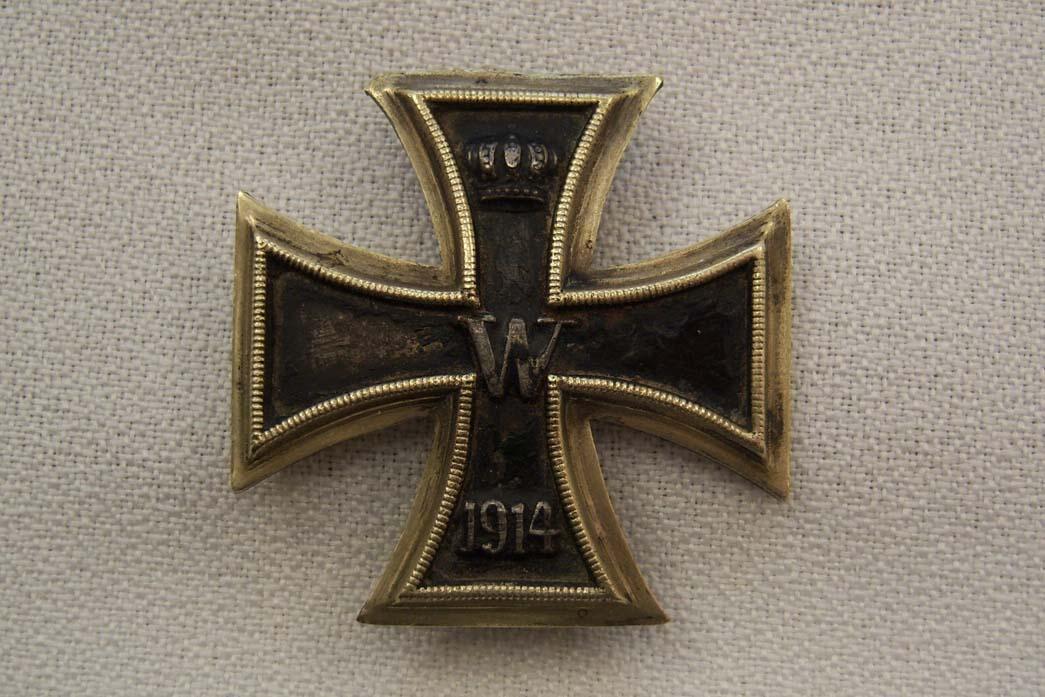
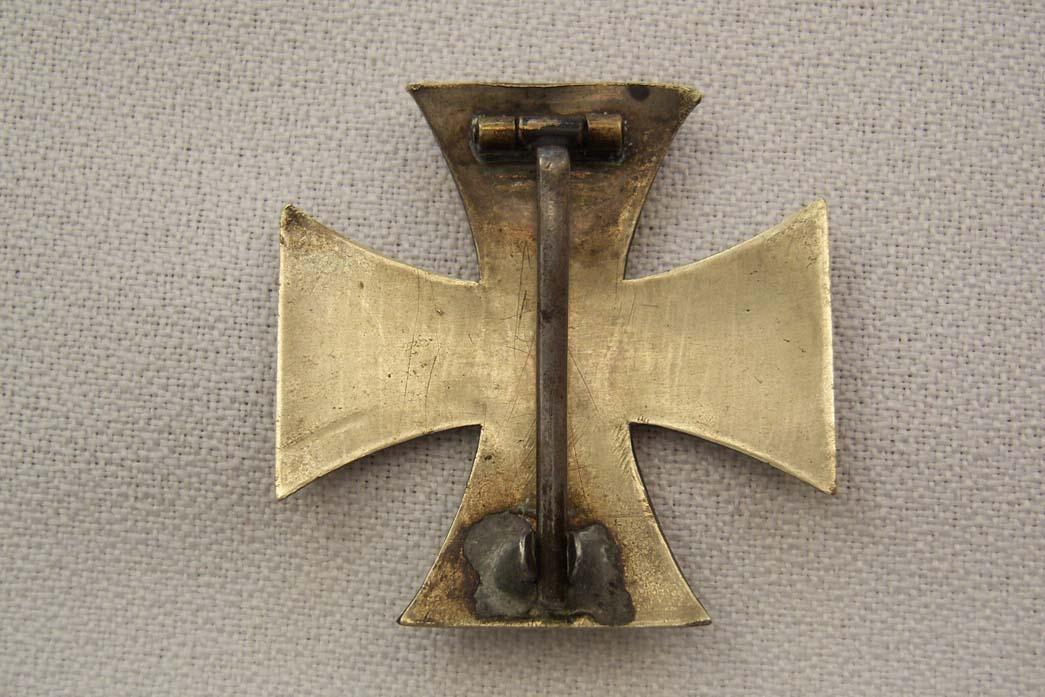 0
0 -
Here is my small police whistle collection.
From left to right:
Buck’s Special Constabulary
A.R.P. with badge
Essex Constabulary
Clarke Leicester
Metropolitan Police London 1942
City Police or Fire Whistle, C.T.W’S
G.P.O. (Post Office)
Kent Special Constabulary
Liverpool City Police
Staffordshire Constabulary
The last, an unmarked specimen, belonged to a
good friend of mine and a former Police Constable “H” Division who served from
1967 to 1974, City of London, Bethnal Police Station (London’s East End). He was a Home Beat or Community Officer. It’s not often you get a whistle with as much
information. The former PC’s name is
withheld to preserve his privacy.Regards
Brian
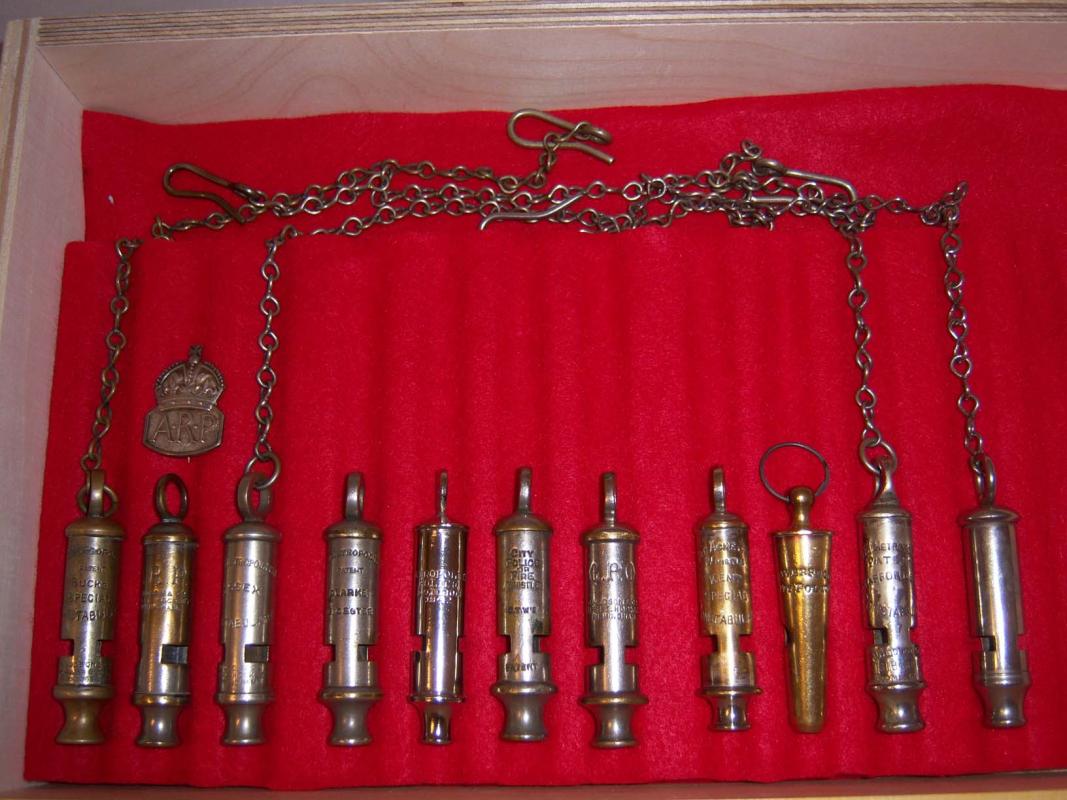 0
0 -
Hello Fellows,
This is a great post and one I've wanted to get involved with for some time now, thank you for starting it off.
My offering in the military is a set of Second World War whistles from 1939 through to 1945. The whistle to the far right, I have been told, is to the Royal Navy, WWII. From what I have read, and I stand to be corrected, the Royal Navy never had their whistles dated and used the doubled neck chain.
I have one lonely First World War whistle dated 1915. I would like to finish the WWI group some day.
Regards
Brian
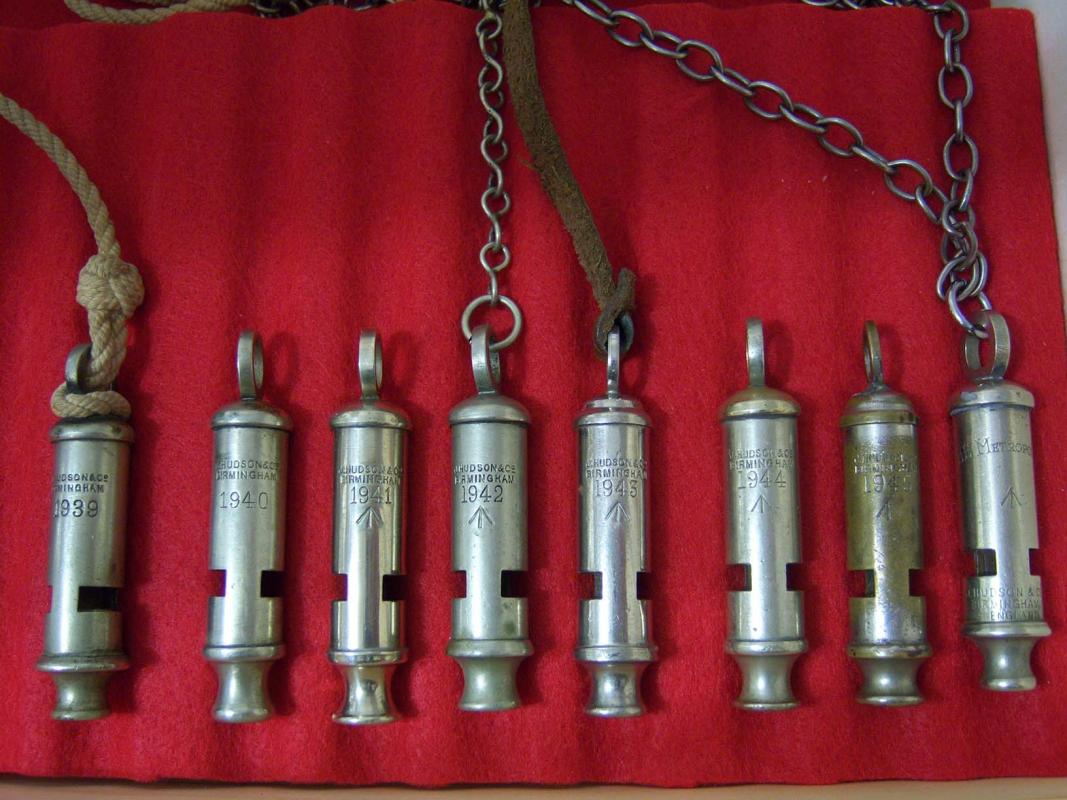
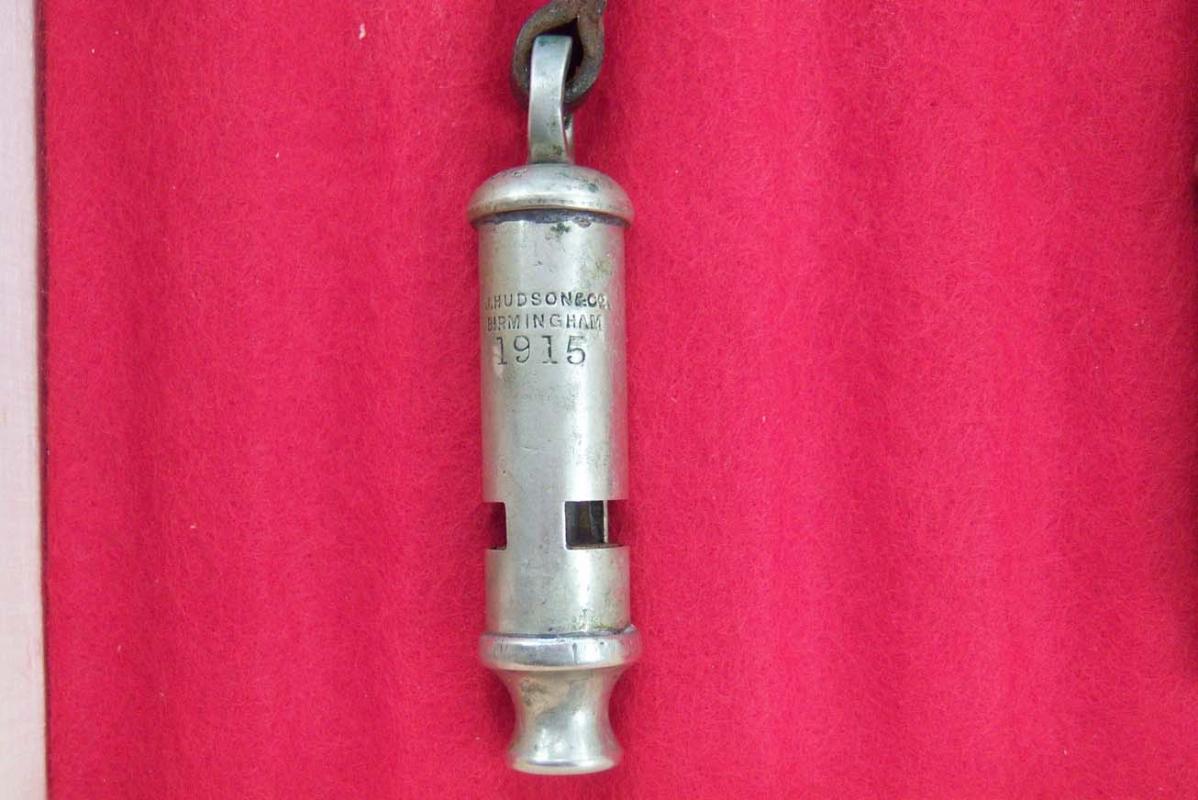 0
0 -
Very nice blueman, what I could do that early in the morning when the kids won't get up.
Regards
Brian
0 -
Oops...I forgot to attach the photo.

Regards
Brian
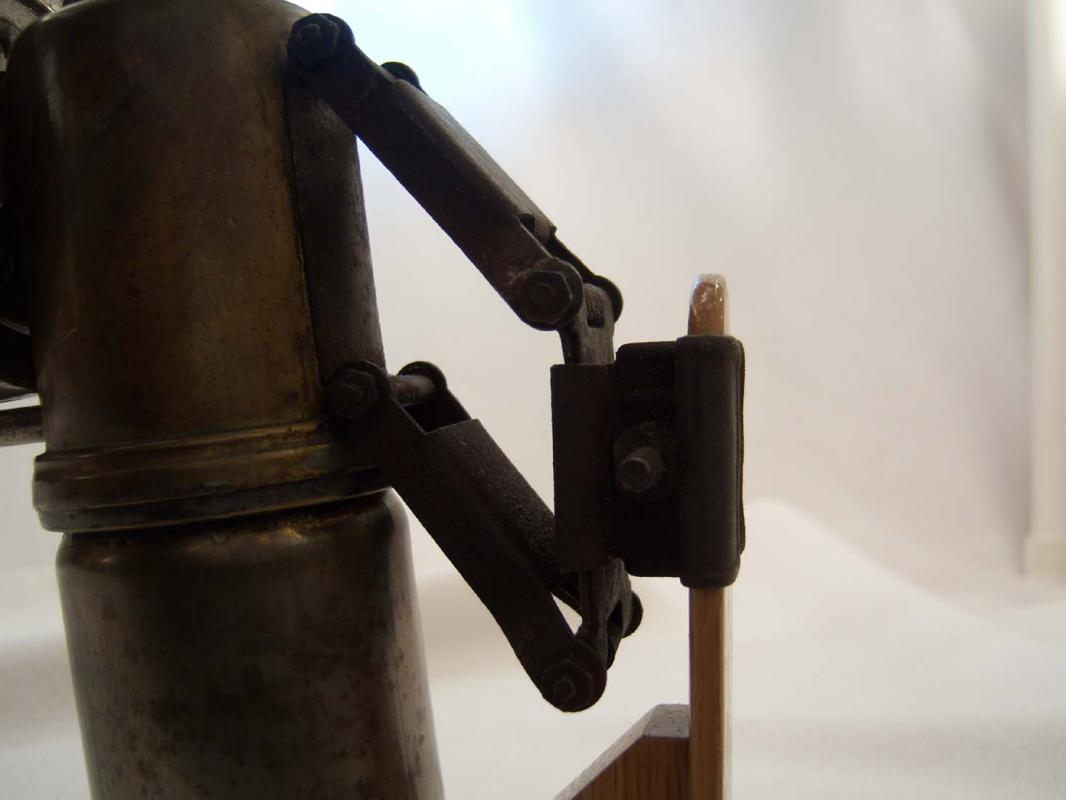 0
0 -
The last photo of this series on the calcium carbonate lamp shows the mounting clamp. The spring sections probably helped to limit vibrations experienced through the frame of the bicycle from the rough road surface. You will notice that the lamp, when mounted, naturally leans somewhat downwards and I would think this was to better direct the light on the road ahead.
I like to display my specimens and since this style of lamp will not stand upright on its own I made the small stand to better show it off as it would have been mounted on the bicycle.
Regards
Brian
0 -
These photos show the burner where the acetylene flame was produced and the light chamber with the reflector at the back. This particular reflector is cracked but still in place.
In the photo you can see that the whole light chamber comes off easily for either cleaning, repair or perhaps for lighting the burner.
When lighting a calcium cabonate lamp the flame, at first, sputters and needs time to "settle down" after which the water drip rate can be adjusted for the amount of light needed. I would suspect that this was done with the light chamber off, then once the flame is under control, replaced. I say this because of the ease at which this section is removed and replaced.
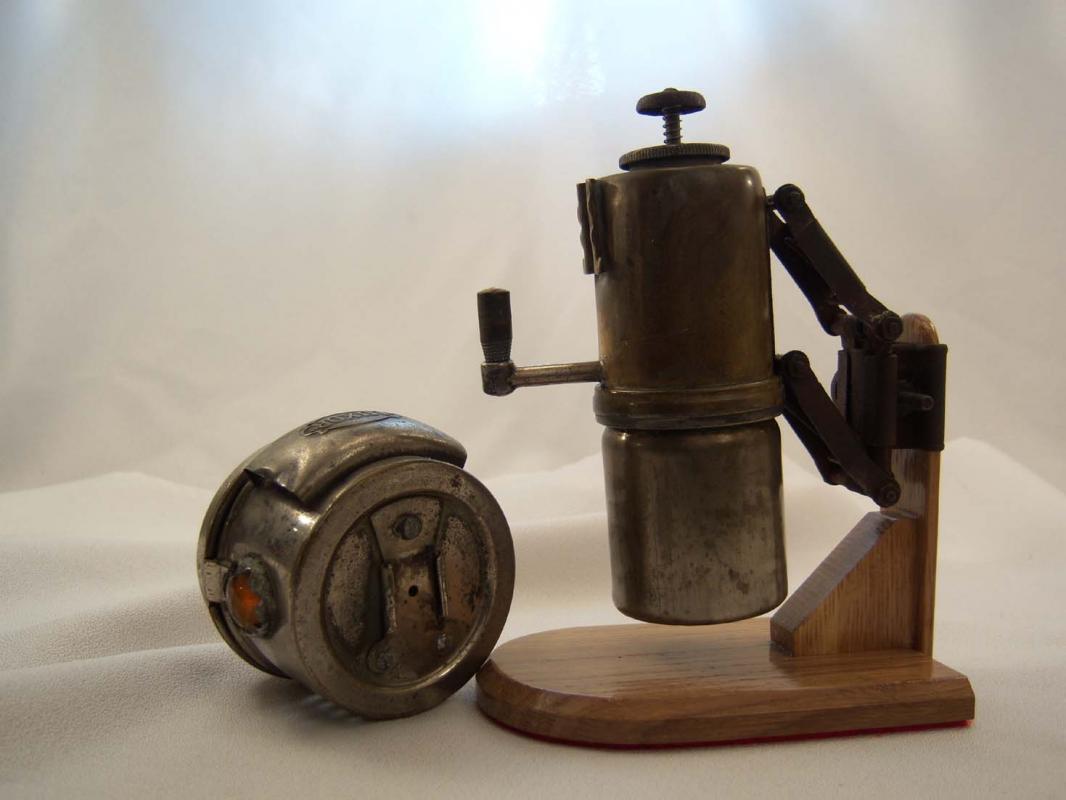
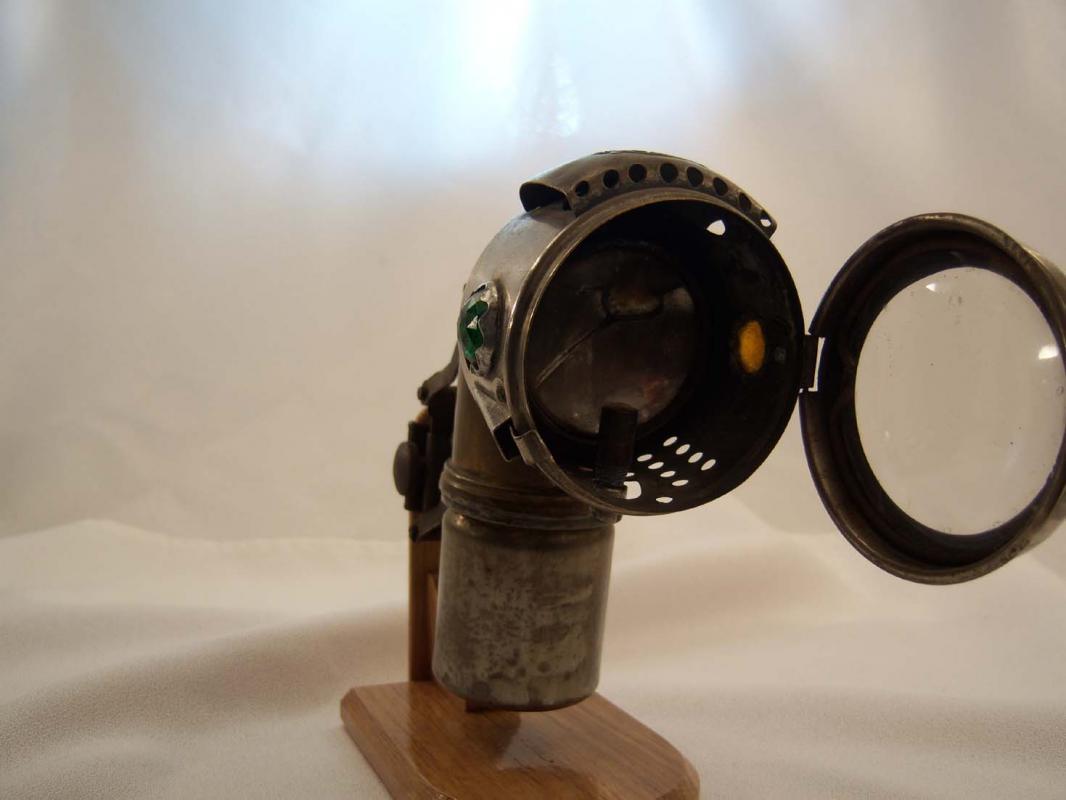 0
0 -
These next two photos show the bottom cup where you would place the calcium carbinate and the top where you would pour in the water. The knob on the top allows the water drip to be increased or decreased as needed.
.
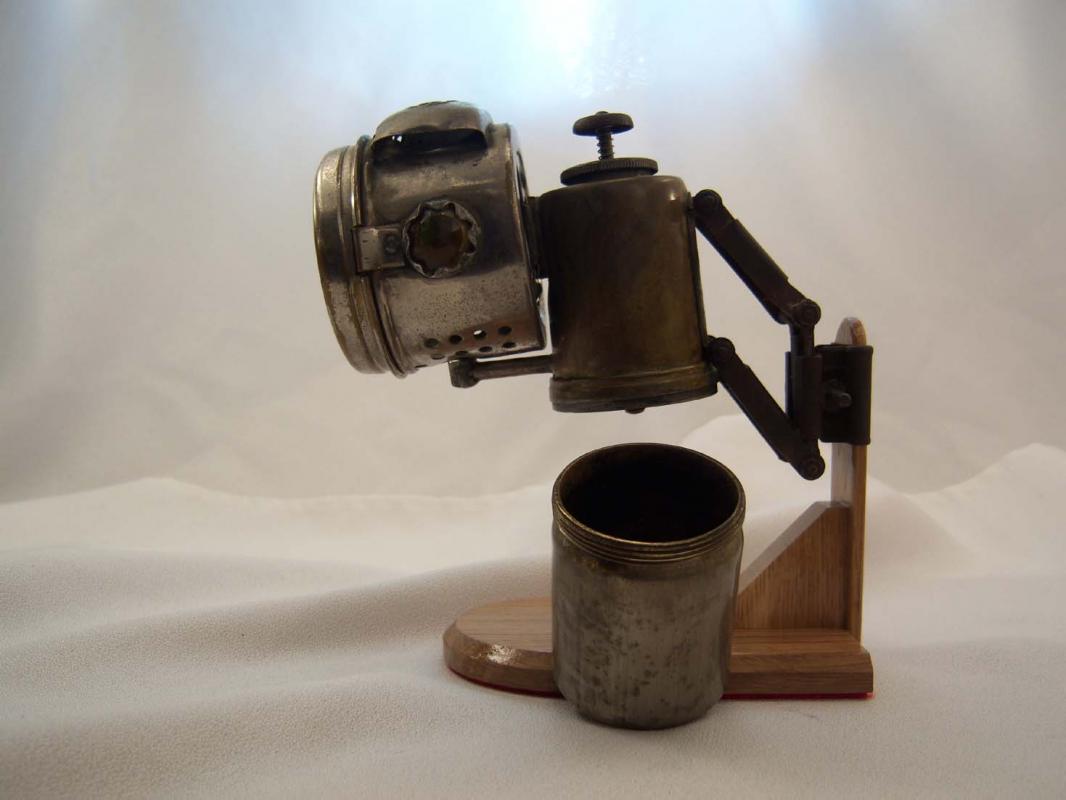
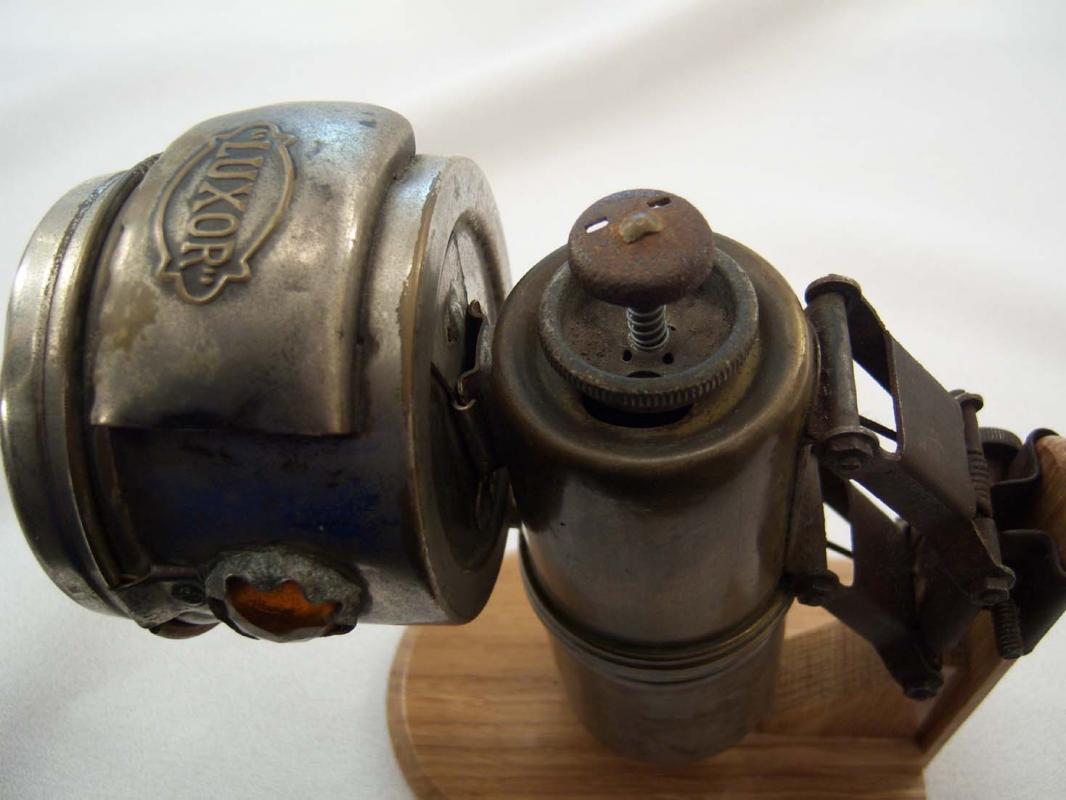 0
0 -
Carbide Bicycle Lamp
There was a need for officers to make use of the bicycle in their patrols, especially in the rural areas. I believe Mervyn may have touched on this in his earlier fictional work about the life of a constable in the early years of
policing in England. Naturally the officer would be required to use a bicycle after sunset and therefore required a light for the same reasons we would need one today.
The lamp I am featuring in this installment is actually a French Luxor Carbide Bicycle Lamp, from around 1910 to perhaps1930.
This lamp is one of my favorite specimens in the collection as it involved more than simply pouring in a fuel and lighting the wick. These lamps required a chemical reaction in order to produce the fuel.
What fascinates me is that the chemical reaction was all within the lamp and not in a manufacturing plant then shipped to a vendor for sale to the lamp user.It required the user to actually mix together two materials to generate the fuel.
My old chemistry teacher would be so proud, and not a little surprised, if he could know that I am writing anything about a chemical reaction.
When I look back I cannot but feel a bit sympathetic for this fellow who persistently remarked that he knew, as his student, I was capable of turning out much better work,
and yet I, just as persistently, disproved his hypnotises over and over.
The carbide lamp required the user to place calcium carbonate in the bottom portion of the lamp and water in a reservoir located above the calcium carbonate container.
The water could be regulated to drip at a controlled rate onto the calcium carbonate below and thereby produce acetylene gas. This gas was then ignited and a light producing flame was the result.By filling the bottom container with calcium carbonate from ½ to ¾ full one could have light for one to two hours. Once the calcium carbonate was used up a white sludge was left which was dumped out and, if needed, the whole process was started over.
I am going to digress from the topic for a moment with a personal opinion. When you think about the process set out above, the user actually created a flammable gas in a miniature manufacturing plant, being the lamp itself. It would seem to me that people back a century or more ago were closer to the actual process required to produce a required result than young people of today.
For those with even a spark of intellect there must have been a stimulation of the thought process lacking in today’s “flip a switch and you are rewarded” world. Through studies and surveys it has been found that an alarming percentage of today’s population have no idea where or how electricity is produced or where the waste goes after they flush the toilet. We seem to be witnessing a generation of lab rats or at least Pavlov’s dogs.I could not resist sharing that thought with you, it’s just an observation.
I’ve read one author’s opinion, somewhere, that these lights served more to indicate the location of the bike rider rather than actually producing sufficient light. I found that a strange comment as I have seen videos where these lamps were show lit and a good deal of light was produced. In fact this type of lamp system was and still is used by people who are engaged in caving. I have read that today the lead person in a cave expedition often uses a calcium carbide lamp as the light has a wider spread than an electrical light while producing a strong beam. I understand the soot produced by the acetylene lamp can be used to mark the cave wall with a dark patch in which may be written, with a finger, directional marks etc. The soot is an eco-friendly medium and will not disturb the cave environment.
I hope you find this lamp as interesting and
as fascinating as I do.
RegardsBrian
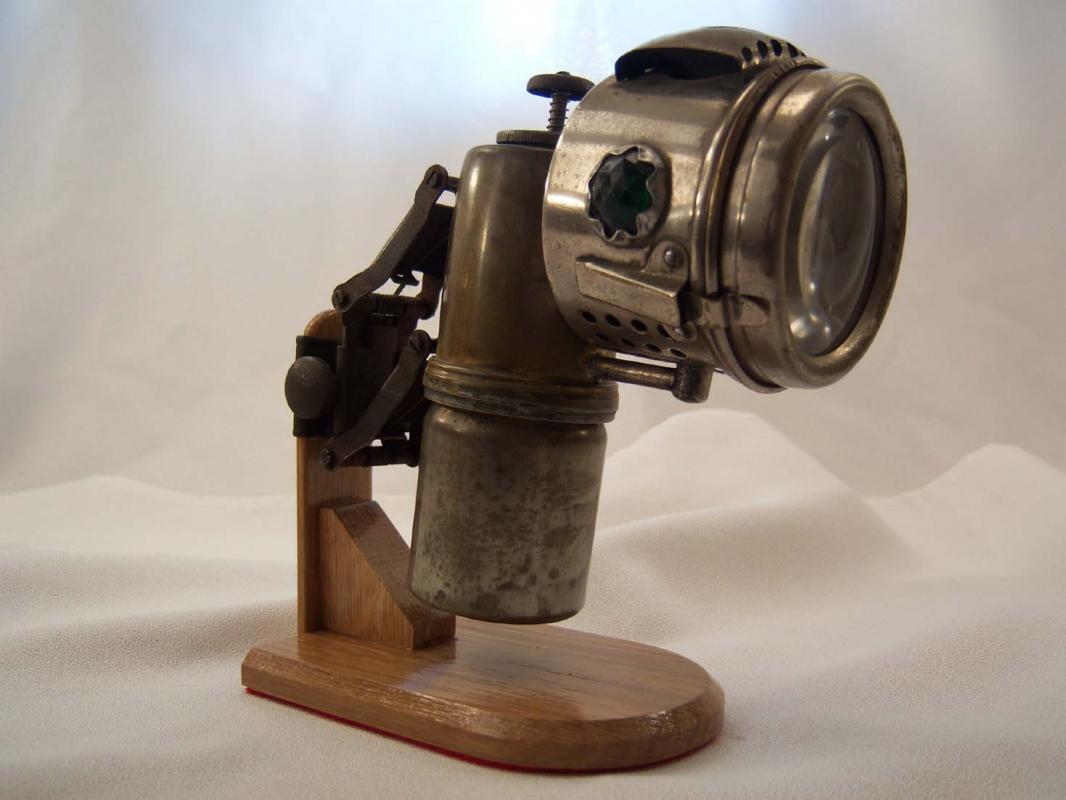
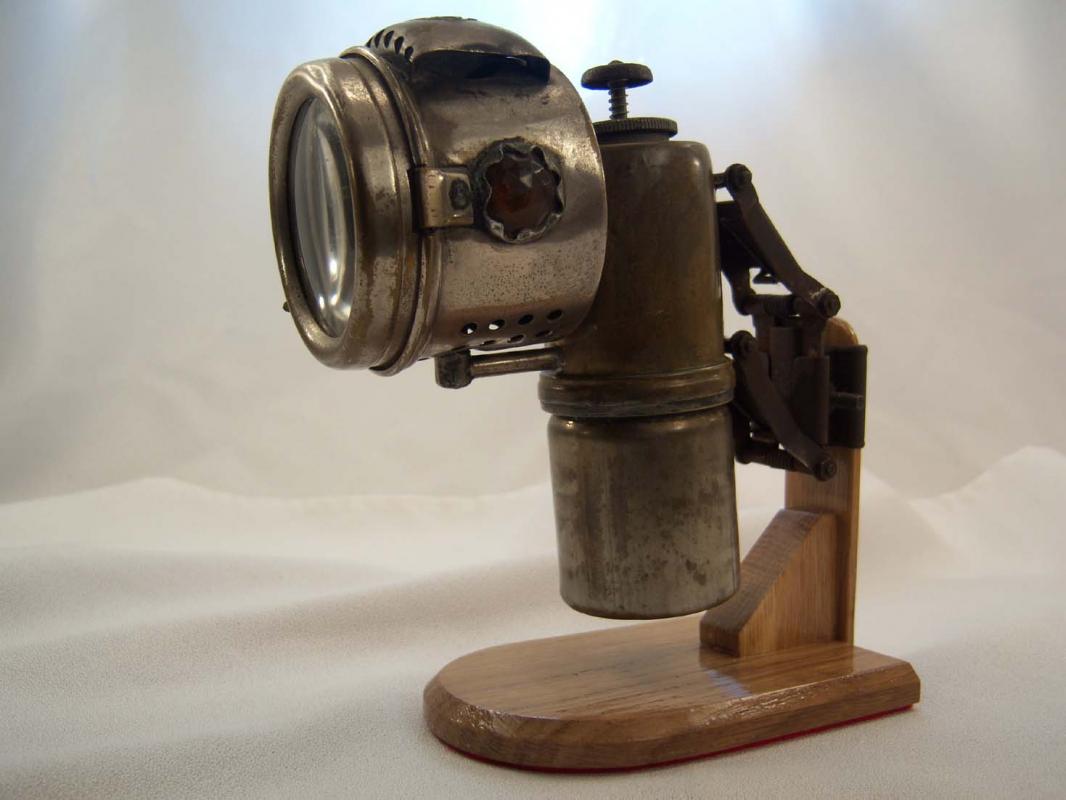 0
0 -
Sorry it has taken so long to respond but I wanted to research your question before confessing failure. So far I have found nothing.
This post has been "pinned" and will remain at the top of the section until I have conpleted it so I hope one of the members with this knowledge will see your question and be able to assist you.
Regards
Brian
0 -
Hello Muckaroon,
I would rather keep this section for British examples only, especially since Mervyn had posted so many great British specimens.
Regards
Brian
.
0 -
Great idea for a post, now to find my secimens and add to the post.
Regards
Brian
0 -
Hello dug,
CHM = Company Havildar Major (Company Sargeant Major).
When it comes to post 1947 Indian medals almost anything is possible, in other words the regualtions may be set down but when it comes time for the medals to be named the regs. go out the window and anything goes.
It is very frustrating for collectors and those interested in Independent India's Military history.
The rank is a good one however, so well done on this addition to your collection.
Regards
Brian
0 -
Hello dug,
Welcome and good to see a new member interested in the medals of India, I wish I could help you but this remains a puzzle.
I'm sorry to say that Mr. Haynes left the forum a number of years ago so we cannot tap into his knowledge base.
If I find anything out I will post it here, I hope you will do the same.
Regards
Brian
0 -
I have moved this post from the Lounge to here with the hope more of our members with an interest in firearms will see it.
Remember iconic firearms can also include those items you have always liked but not necessarily own yourself.
Regards
Brian
0 -
Excellent video, many thanks for posting it.
The weapon fired was a Model 1853 Three Band rifle musket, I believe. Not that it matters as the priciple is the same.
One point (a personal opinion) is that the weapon should only be at half cock when the percussion cap is placed on the nipple. To carry out this action at full cock, as in the demonstration, is inviting an accidental discharge, as these were not equiped with a safety device, except for the half cock position.
I just checked my own M1853 and the half cock position allows the precussion cap to be installed with no problems, in case anyone was wondering. A soldier would then raise the musket to his shoulder while engaging the hammer to the full cock position and fire the weapon.
One would not want to blow the sergeant's head off "accidently" by carrying out this proceedure at full cock.

Regards
Brian
0 -
Nice.
I suppose it would be quicker to list who didn't use this one.
This is the British Land Pattern Musket (aka Brown Bess), isn't it?
Regards
Brian
0 -
Both my wife and I are more interested in the Fenian Raids than the War of 1812 as well.
She has the Canadian General Service Medal part of the collection and I must say I am impressed wih her medal collection.
Here's to cross border shopping and historical interest friendships.

Regards
Brian
0 -
Shall we discuss Canada's war obssession... AKA "We won the War of 1812!"
 :lol:
:lol:  :lol:
:lol: 
Gladly, however, you seemed to have already arrived at the only logical conclusion to any discussion we might have on the subject.

In reality, we can discuss a war between our two countries (even though we didn't become a nation until 1867), accept the other fellow's opinion as his right to his own opinion, and part as friends.
If that isn't something both sides can be proud of, I'm not sure what is. Sounds like everyone, except the First Nations, won.
Regards
Brian
0 -
I'll stay clear of the debate, being a Canuck, and simply say that this is a very nice specimen.
I wouldn't worry about the "serious" collectors, they will always find examples of what they need for their collections.
Regards
Brian
0 -
A wonderful job of remounting, Mervyn.
I too would like to hear more about this group.
As Dante has asked, "What are the clues" and I'd like to also know the conclusions you have drawn.
In your original post you mentioned that this is a lesson that medals are not something to be played with. Is there a specific story to this statement concerning this particular group?
Regards
Brian
0 -
You could not have picked more iconic firearms to represent the Old West than the Colt 45 "Peacemaker" and the Winchester 73. They were "the best of the west". I hope someone will show the Navy Colt as well.
This is already a post that generates dreams for me of future collecting conquests.
Your comment about being a time when it was alright to shoot the badguy is spot on. Back when I was a kid and all of the Western movies were in black and white it seemed that the world was indeed more "black and white" regarding what was right and what was wrong. Now almost all movies are shot in colour and the world is "gray".
Thanks for posting a couple of firearm greats.
Regards
Brian
0 -
"Now for the question, keeping in mind that to me these are iconic of the old west saloon gambling table, what is the down card in the photo?"
Black aces and eights. The Dead Man's Hand. Actually, Wild Bill Hickok's hole card is supposedly unknown. Historical displays like to display it as a card from the suit of Diamonds - a five, nine or a jack - even a joker. Deadwood likes the Queen of Clubs. But it doesn't really matter - because Hickok was shot before playing out the hand.
Hi Irish,
I had a feeling that you would be the one to answer the question. I didn't expect that you would answer the hole card so completely.

I'm going to go with Deadwood and say it was the Queen of Clubs.
Well done.
Regards
Brian
0




Grandfather / Grandson Jiffy Bag Dance - The Jack Family - 25th Bn CEF
in Great Britain: Orders, Gallantry, Campaign Medals
Posted
Hi Mike,
A very nice grouping and I agree that every now and then we just have to step outside of our collecting areas when something like this comes along.
Well done.
Regards
Brian